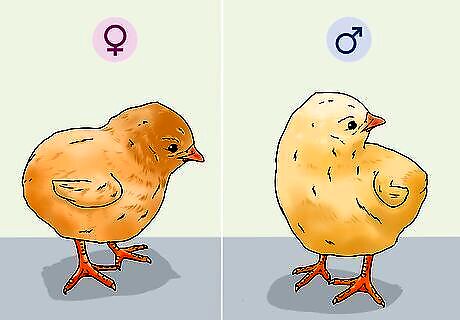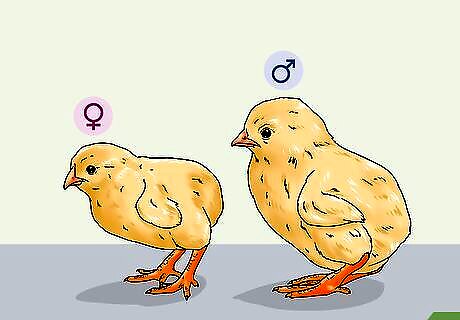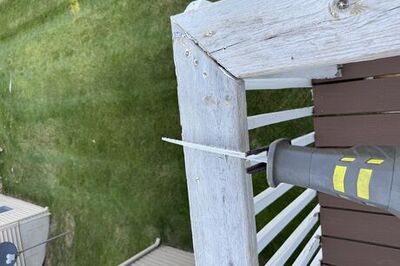
views
- When sexing chicks, look for larger bodies and uniform wing feathers, because these are signs that the chick is male.
- With older chicks and chickens, identify male birds by their facial comb skin and their jagged, sharp saddle feathers.
- Laser spectroscopy readings can identify the sex of a chick inside of an egg at about 3 days after incubation.
Inspecting Recently Hatched Chicks

Look at their wing feathers. While baby chicks are covered in down, the ends of their wings will have a light feather fringe. To view the wing feathers, grasp the chick firmly in one hand. Use your other hand to extend the wing out until the feathers are somewhat separated and visible. A male (cockerel) chick will have wing feathers of roughly the same length. A female (pullet) chick will have wing feathers featuring two varied lengths. You can perform wing sexing 1 to 2 days after hatching and usually get accurate results. If you wait longer than this, the wing feather development will accelerate too much to read.

Look at their down color. A chick is covered with downy, soft, small feathers until it develops past 6 weeks of age. Male chicks usually have light-colored heads, whereas females often have dark brown ones. If a female has down spots or stripes, they are typically brown or black. In contrast, a male’s accent marks are generally white or yellow. For example, male Rhode Island Red or New Hampshire chicks will have almost golden down coloring. Similarly, Red Stars are a sex-linked breed, so the male and female are different colors. Males hatch buttery gold, while females hatch reddish-gold. In some situations, you can estimate the sex of a day-old chick using down color reading. Certain breeds will have sex-unique down patterns. For example, male Barred Plymouth Rocks chicks will have yellow spots on their heads.

Look at their size. At about 3 to 4 weeks old, you should be able to start to tell the difference between male and female chicks based on their body size. Male chicks will generally have larger bodies and heads. Female chicks will appear a bit more petite.

Attempt vent sexing. A warning in advance, it’s usually best to hire a professional to perform this procedure. However, if you choose to do it yourself, make sure to be gentle with the chick. Hold the chick in your hand and apply light pressure to its abdomen until the chick defecates. Look into the now clear anal vent. If you see a bump, then the chick is likely male. No bump indicates a female. In some breeds, both males and females will have what looks like a series of small beads in their anal vent. In these cases, the male will have a larger, round center bead. The female center bead will be flat in appearance.

Wait until the chicks are 6 weeks old. If you are willing to wait this long to determine the sex, then your odds of success increase quite a bit. The physical changes, such as waddle development, will be easier to see. The behavioral changes, like the startle response, will also be more clear and consistent. In addition, if you wait for a few months, then the males are likely to start crowing.
Examining Older Chicks and Chickens

Monitor comb development at 6 weeks. By this point, male chicks will have fully developing combs, the fleshy extensions on the facial areas. You will notice the combs extending directly above the head. The comb skin will also turn red. In contrast, the female chick’s facial skin will stay yellow and unextended.

Examine the saddle feathers if the chick is between 8 and 10 weeks old. Hold the chick firmly in your hand and look where its back meets its tail. That is where the saddle feathers lie. You will notice that male chicks have jagged and sharp saddle feathers, whereas the feathers on females look more rounded and soft.

Consider temperament. As you watch the chicks socialize together, try to pay attention to which birds display dominant or submissive tendencies. Male chicks will act less skittish and are more likely to bully their peers. Female chicks are more easily frightened by loud noises and will freeze in response. Another way to observe the fight-or-flight response is to approach the chicks while clapping your hands. The male chicks will issue warning chirps, while the females will usually stay silent.

Look at the wattles of adult chickens. The wattle is the loose, hanging skin underneath a chicken’s beak area. As a chicken matures, their wattle will grow in size. However, a male chicken’s wattle will also become brighter in color, usually taking on a reddish tone. A female chicken’s wattle will stay yellow, white, or gray.

Watch for egg laying if inspecting adult chickens. If your chicken lays an egg, then it is clearly a mature hen (female). This can happen anywhere from 12 to 30 weeks of age. A rooster (male) cannot lay an egg, but may start crowing loudly around this same timeframe.
Evaluating Other Sexing Options

Use laser spectroscopy for commercial purposes. This is a new technique that involves a lab shooting a small laser beam inside of an egg about 3 days after incubation. The technicians then use the DNA contents of the egg to determine the future sex of the chick.

Get a “sex link” chick. These are chicks that are bred to exhibit a sex-specific color pattern at hatching. This means that you will be able to tell the sex of the chicks almost immediately with a high degree of accuracy. Red Stars, for example, are a sex link breed. Males are yellow golden, whereas females are reddish gold.

Hire a professional. Ask around with your local farm supplier or other poultry farmers to see which “chick sexer” they would recommend. These professionals usually have extensive experience in sexing chicks and travel from location to location doing exactly that. They will generally charge you a flat fee for accurately sexing a certain number of chicks.

Don’t trust egg shape reading. Some old wives’ tales suggest that males come from pointed eggs and females from rounded ones. The idea is that just looking at the egg’s shape can tell you the sex of the chick. However, this method has been discredited over time and has about the same accuracy as a guess.

Select a method with more than 50% accuracy. If you just guess the sex each time you select a chick, you would end up being right around half of the time. For that reason, if you want to consider a sexing method a success, then its accuracy odds must be higher than 50%. Keep track of the methods that you use, your guesses, and the final results to see what works best for you.


















Comments
0 comment